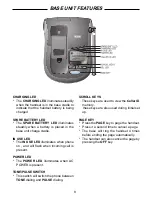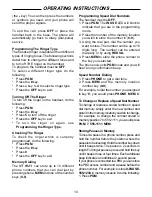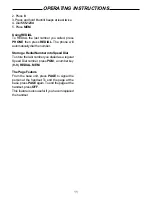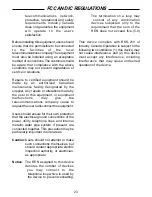
22
FCC AND IC REGULATIONS
circuit different from that to which the receiver
is connected.
* Consult the dealer or an experienced radio/
TV technician for help.
FCC Part 68
The FCC requires that you connect your cordless
telephone to the nationwide telephone network
through a modular telephone jack (USOC RJ11C
or RJ11W).
Your telephone company may discontinue your
service if your equipment causes harm to the
telephone network. They will notify you in advance
of disconnection, if possible. During notification,
you will be informed of your right to file a complaint
with the FCC.
If it is determined that your telephone equipment
is malfunctioning, the FCC requires that it not be
used and that it be unplugged from the modular
jack until the problem has been corrected. Repairs
to this telephone equipment can only be made
by the manufacturer or its authorized agents or
by others who may be authorized by the FCC.
For repair procedures, follow the instructions
outlined under the VTECH Limited Warranty.
The REN is useful in determining the number of
devices you may connect to your telephone line
and still enable the devices to ring when you
receive a call. The general rule is that the REN
value should not exceed 5.0 total; however,
contact your local telephone company for the
specific number in your area.
IC (Industry Canada)
This telephone is registered for use in
Canada.
Notice:The Industry Canada label identifies
cer tified equipment. This
cer tification means that the
equipment meets cer tain
FCC AND IC REGULATIONS
This equipment complies with Parts 15 and 68 of
the Federal Communications Commission (FCC)
rules for the United States. It also complies with
regulations RSS-210 and CS-03 of Industry
Canada (IC).
A label is located on the underside of the base
unit containing either the FCC registration number
and Ringer Equivalence Number (REN) or the
IC registration number and Load Number. You
must, upon request, provide this information to
your local telephone company.
This equipment is compatible with inductively
coupled hearing aids.
FCC Part 15
Warning:Changes or modifications to this unit
not expressly approved by the party
responsible for compliance could void
the user's authority to operate the
equipment.
The equipment has been tested and found to
comply with part 15 of the FCC rules. These limits
are designed to provide reasonable protection
against harmful interference in a residential
installation. This equipment generates, uses and
can radiate radio frequency energy and, if not
installed and used in accordance with the
instructions, may cause harmful interference to
radio communications. However, there is no
guarantee that interference will not occur in a
particular installation. If this equipment does cause
harmful interference to radio or television
reception, which can be determined by turning
the equipment off and on, the user is encouraged
to try and correct the interference by one or more
of the following measures:
* Reorient or relocate the receiving antenna.
* Increase the separation between the
equipment and receiver.
* Connect the equipment into an outlet or on a


































